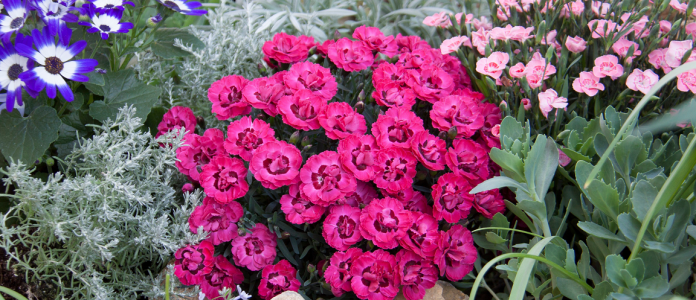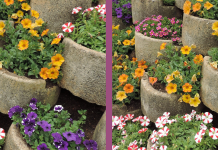Downsizing your home usually means adapting to a smaller garden too. Or it could be that you just want to reduce the amount of garden you need to maintain.
Gardening smaller and smarter makes it easier and you can still enjoy and beautiful garden.
Keep it close:

The closer the garden is to the house, the easier it is to care for and enjoy. The plants are under your eye so you can see if they need extra water, feeding or trimming.
A mixed border of compact flowers and ornamental grasses around the stoep can be very showy. Try to match the colours to your patio furniture or indoor colour scheme. It extends the feeling of indoor-outdoor living. Shrubs and perennials that need less care can be planted further away.
Try these:
Compact and fragrant Dianthus ‘Pink Kisses’ , ‘Early Love’ (above picture) or ‘Purple Wedding’ produce masses of tiny, bicolour flowers in shades of pink and purple. These bushy plants, 35cm high and wide are perfect for garden borders. Cut back after flowering for a repeat flush of flowers.

Novelty petunias like ‘Petunia Capella ‘Sangria’ are compact, rounded plants that fit in anywhere and everywhere that’s sunny. It’s a good mixer in garden beds, as an edging, massed, or in a hanging basket or container. Plants grow 30cm high and 36cm wide. Cutting off the dead flowers encourages it to produce more. As a bonus, the flowers attract butterflies, nectar seeking birds and bees.
Get clever with containers:

Flower-filled containers can be hard work because they need daily watering and regular trimming. But they are beautiful too, especially as features. Rather reduce the number of containers but fill them with the most dramatic plants you can find.
There are many Calibrachoa varieties that easily fill containers and need very little care, as most are self-cleaning and don’t need dead heading. Calibrachoa ‘Mini Famous’ (picture above) has double flowers that appear like rosette. They are hardy, drought tolerant plants with a long flowering season.

A neat, compact, (45cm high and wide) zonal variety is Pelargonium ‘Kariba’ that has large blooms in shades of pink, purple, and red as well as white. Nourish with a liquid fertiliser once a month; it will reward with more flowers, especially if old flowers are removed.
Less is more:

Even if downsizing reduces you to a patio or balcony, that doesn’t mean forgoing plants or flowers. Compact flowering plants for tabletop containers or hanging baskets, like Fuchsia Bella (above) as well as creepers that are not too vigorous can brighten an outdoor living area without too much effort.

Diamantina ‘Jade Red’ is a compact Dipladenia climber (aka Mandevilla) that produces a mass of scarlet coloured flowers that show off against shiny evergreen foliage. It can be grown as a bush or a compact climber (30cm high) and is ideal for patio pots, a balcony, or at the entrance of a house. It may partly defoliate in a cold winter but will regrow in spring.

Lobelia “Curacao” (height 15 to 25cm) is a heat tolerant, semi-trailing plant that easily fills a hanging basket. Besides the deep true blue, it is available in dark purple, blue with white eye and light blue. The secret with hanging baskets is to make sure the basket is at eye level. This makes it easier to water, and trim.
Replace demanding plants with sustainable varieties:

Opt for plants that are drought tolerant, and don’t need staking, dead heading or extra feeding. Also, avoid plants that spread too quickly and over grow others.
Some real garden stalwarts include the compact gaura Belleza, the white flowering Euphorbia ‘Breathless’ or ‘Glitz’, various perennial salvias like “Mirage’ burgundy or deep purple, Russian sage Perovskia’ Blue Steel’ and Scaevola Bondi which has lavender or white fan shape flowers on compact plants.

Russian sage (Perovskia atriplicifolia) ‘Blue Steel’ carries clouds of small lavender-blue flowers above aromatic, silvery foliage. Plant in full sun in soil that drains well. It is quite compact in its first year (45 – 60cm high) and then develops into a showy 97cm high plant in its second year. Cut back plants in spring to encourage strong new growth.
For more information: www.ballstraathof.co.za
TEXT: Alice Coetzee






